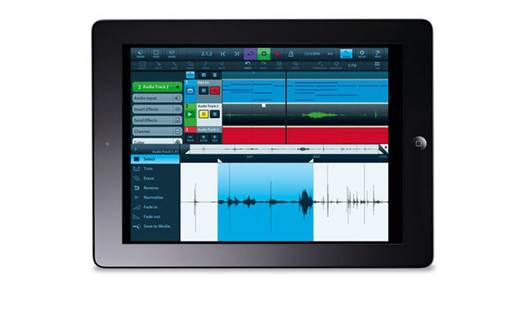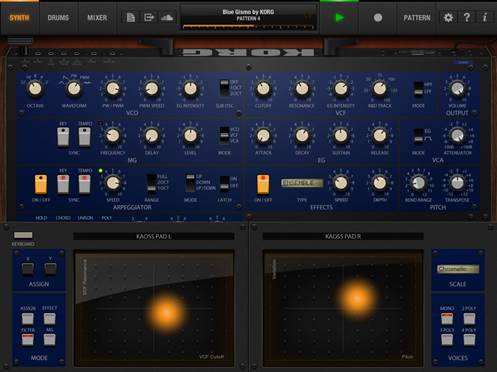A rapid-fire round-up of sample
libraries, ROMplers, apps and more
Steinberg Cubasis
Price: $53
Format: iPad

GarageBand aside, it was only a matter of
time before one of the major DAW developers became the first to bring a big
brand to iPad, and that developer, it turns out, is Steinberg. Cubasis captures
the essence and spirit of Cubase in a multi-touch MIDI/audio sequencer that,
obviously, doesn't come anywhere near the full specification of its Mac/PC
parent but does give Cubase users a mobile counterpart with project export to
versions 6.5 and 7.
With audio and MIDI track counts limited
only by your iPad’s processing power, Cubasis can record via the mic or a Core
Audio/Core MIDI interface. MIDI parts are edited in a piano roll (draw, move,
delete, quantize and transpose notes), while the audio editor has a set of
basic processes (there’s no time stretch or pitch shift).
Around 70 HALion Sonic sampled instruments
are included, but while they’re of decent quality, stylistically they’re
nothing to get too excited about, comprising plenty of guitars, keyboards,
drums and orchestral instruments, but precious little in the way of interesting
electronic sounds.
‘Generic’ is definitely the word, and with
attack and release being the only editable parameters on offer, there’s really
no getting away from it. The same goes for the 300 MIDI and audio loops, which
could cheerfully serve as placeholders but little else.
Ten effects are onboard (three inserts per
channel and three fixed aux buses sending to two delays and a reverb), and
these are pretty effective, despite their minimal controls.
It’s in the arrange page and mixer that Cubasis
really shines, with multi-touch making navigating, editing and mixing supremely
smooth and easy. As usable and impressively ‘Cubase-like’ as it all is, though,
the price is a little hard to swallow, especially for non-Cubase users.
GarageBand might not be as powerful, but it’s certainly in the same ballpark at
less than a tenth the price. Cubase diehards probably won’t regret buying it,
though, especially if Steinberg can wheel out some canny updates.
Toontrack New York Studios Vol 3 SDX
Price: $192
Web: www.timespace.com
Format: SDX for Superior Drummer 2.0

The New York Studios series is the center piece
of Toontrack’s amazing Superior Drummer virtual drum kit system, the core
library itself constituting Volume 1 (recorded at Avatar Studios), and the
first add-on SDX being Volume 2 (recorded at Hit Factory NY and Allaire).
Volume 3 sees Toontrack returning to Avatar
to capture three full vintage drum kits and some supplementary snares, as well
as a sizeable collection of cymbals. We say 'returning’, but actually, the
original sessions were done in 2006, with engineers Neil Dorfsman and Pat
Thrall retrieving the recordings from the vaults last year for production - so
it’s really a prequel.
With the full install weighing in at 18GB,
NY3 is very much "more of the same”, certainly, but Superior has always
been all about lovingly recorded acoustic drums rather than crazy electronic
sounds or percussive esoterica, and as any Superior user will attest, adding to
the library with a new kit or two is always a thrill.
The drums, then, comprise 1964 Slingerland,
1979 Ludwig and 1966 Rogers kits, with extra snares by GMS and an unknown
manufacturer. The cymbals are almost all Sabians (the HHX series being the most
represented), and there are a lot of ’em, covering a broad sonic spectrum.
The Slingerland kit is our favorite, with
its tight, funky kick and snare, and dry, musical toms. Beyond that, it’s all
big kicks and toms, throaty snares and a generally 'rock’ vibe. The Ludwig
setup (powered along by its hefty 24" kick and 6V2" snare) sounds
‘thumpier’ and perhaps a bit less buoyant than the other two, but the three
kits complement each other well. The recording quality throughout is stellar
(see the website for the list of gear used, headlined by Avatar's Neve 8068
console), and making your own presets by mixing up kit elements and working
theSD mixer is as fun and productive as ever. There’s also the usual library of
genre-categorized MIDI files, performed by renowned sessioneer Nir Z, to use as
starting points for your own programming endeavors.
Another fine addition to the SDX line,
then!
Korg iPolysix
Price: $31
Web: www.korg.com
Format: iPad

While Steinberg might be new to the iPad
game, Korg are veterans, with emulations of their Electribe and MS-20 hardware
already on Apple’s tablet. While what we really want are Wavestation and MS2000
apps, iPolysix will fill the time nicely until one of them comes along.
The original Polysix is a six-voice synth
from the early 80s most notable for its affordability and fabulously warm
analogue sound. The iPad version again ticks both of those boxes, comprising
not one but two synth engines, as well as a six-track drum machine that uses
sampled Polysix sounds as source material. And while it might be quite
expensive for the App Store, it’s excellent value for money in terms of sound,
features and the amount of work that’s clearly gone into it.
The two synths are replicas of the Polysix
with a few little extras thrown in (a high-pass filter, for example), so
they’re eminently easy to program. Essentially, you get one oscillator (with
sub) per voice, a filter, an envelope and an LFO with which to craft your raw
tones. These can then be animated with the built-in arpeggiator, beefed up
using the Unison feature and processed by one of a library of 28 simple but
impactful effects (expanding somewhat on the original’s Chorus, Phaser and
Ensemble).
The Polyseq 64-step polyphonic sequencer
enables you to record/ program patterns for both synths and the drums, complete
with parameter automation and a series of inspiring sequencing modes. Oh, and
you also get two Kaoss Pads for real-time performance and modulation, a basic
mixer, and project sharing via Polystage, which gives you access to other
users’ work for ‘remixing’.
Seriously, what can we say? $31 for a
hugely convincing dual Polysix emulation from the company that built the
original, with touchscreen control and a whole electronic studio wrapped around
it? It’s a beautiful piece of work, and the recently released Version 1.1
brings Audiobus and iCIoud backup to the party, making iPolysix even more
unmissable.